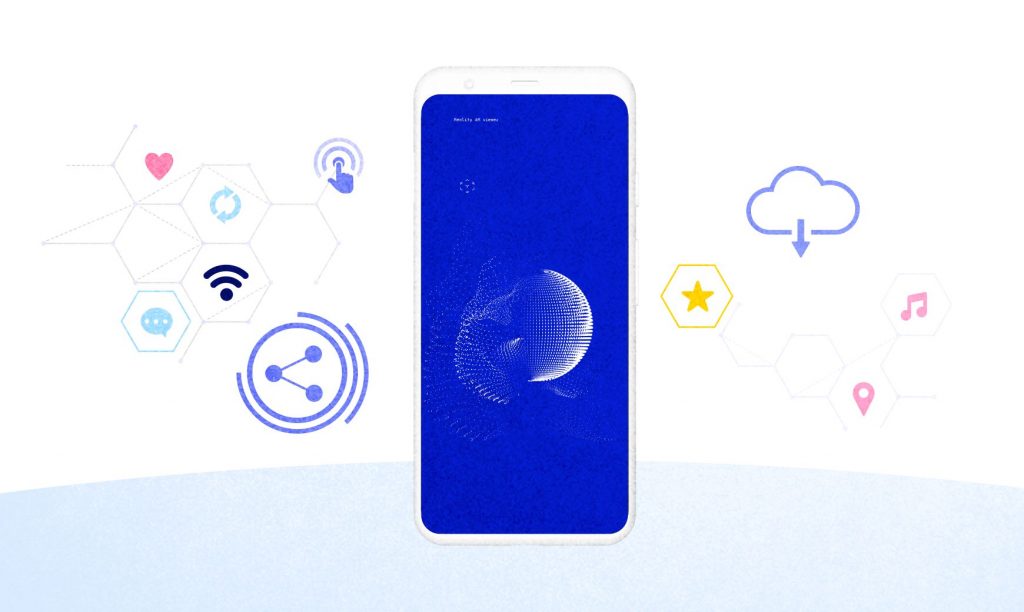
Did you know that by the end of this year, mobile apps are expected to generate astonishing revenue of more than $935 billion? That’s right! These skyrocketing figures reflect the enormous potential and scope of mobile app development. So, what are some of the trending technologies that are shaping its future? Let’s dive in and discover.
1. Machine learning and Artificial Intelligence (AI)
Ever wondered about the reason why the apps you use are becoming increasingly smarter? The answer lies in the integration of Machine Learning and Artificial Intelligence into mobile apps. Combining these technologies is not a matter of simple addition; rather, it’s about creating an entirely new kind of synergy. But how you ask? Let me enlighten you.

Machine Learning, particularly, helps in analyzing data patterns to aid in decision-making, while Artificial Intelligence enhances user engagement by making the interface more interactive and personalized. Consider for instance, how Spotify suggests songs or Netflix recommends series tailored specifically to your taste. That, my friend, is the magic of AI and ML. Exciting, isn’t it?
- Personal Recommendations: Ever wondered how your favorite shopping app always seems to know what you need? That’s AI and ML working tirelessly in the background to analyze your browsing history and preferences.
- Enhanced Security: From facial recognition to fingerprint scans, AI and ML are making strides in fortifying mobile app security. Your information has never been safer!
- Health Monitoring: Helpful reminders to maintain your fitness routine, all thanks to AI and ML. Can you say no to a healthier lifestyle when technology makes it so easy?
- Social Media Content: Notice how your social media feeds always align with your interests. It’s thanks to these smart technologies analyzing your past likes and interactions.
So, are you ready to embrace the dawn of a smarter era in app development? It seems that the integration of AI and machine learning in mobile apps is not just a passing trend but quite possibly the future of mobile app development. Are we witnessing the rise of thinking machines? Only time will tell. But one thing is for sure – this union is transforming the user experience in incredible ways.
2. Internet of Things (IoT) integration
Have you ever dreamed of a future where every device around you is interconnected and communicates seamlessly? Well, it’s not just a dream anymore. We’re rapidly advancing towards a reality where the Internet of Things (IoT) is commonplace. But, what is IoT and why does it matter in mobile app development, you may ask? Let me explain.
IoT is a network of physical objects or “things” embedded with sensors, software, and other technologies for the purpose of connecting and exchanging data with other devices and systems over the internet.
What’s fascinating is that these “things” can range from everyday household items to sophisticated industrial tools. But here’s the exciting part – mobile applications are key to accessing and managing these smart devices. So, IoT integration is becoming more and more essential to mobile app development.

So, how exactly is IoT shaking up the world of mobile app development? Here are a few key points:
- By providing users with the ability to interact with their surroundings in ways we’ve never imagined before. Think about it, controlling your home thermostat, lights, or security system right from your mobile app? That’s an empowering thought, isn’t it?
- It promotes data-driven decision-making by providing real-time access to data. This could range from health stats from your fitness wearable to the moisture levels of your indoor plants. Fascinating, right?
- It takes user convenience to the next level by automating repetitive tasks. Imagine waking up to your favorite music, with your coffee ready, and your home at the optimal temperature – all orchestrated by an application on your mobile phone. Now, that would make mornings less daunting, don’t you agree?
- Last but not least, IoT integration in mobile apps opens up fresh avenues for business by creating new needs and solutions.
All these advancements mean that IoT integration skills are a must for any wannabe or experienced mobile app developer. It’s a crowded market out there, but developers with a knack for creating intuitive, IoT-integrated mobile applications will stand out from the crowd.
So are you ready to harness the potential of IoT in your next mobile application? Remember, in this rapidly evolving digital landscape, staying ahead of the curve is the name of the game!
3. Mobile Commerce
Let’s delve a little deeper into mobile commerce, shall we? Ever asked yourself why e-commerce giants like Amazon, Alibaba, or eBay are devoting serious resources to enhancing their mobile applications? You see, it’s quite simple—they understand the future.
The rise of the smartphone era has spurred an insatiable demand for online shopping, steeply inclined towards mobile platforms. Mobile devices are fundamentally changing e-commerce, allowing consumers to shop anytime, anywhere, and transforming the brick-and-mortar shopping experience.
- Speed: Mobile apps offer better personalization and thereby faster services when compared to websites. They store their data locally on your device, which significantly speeds up the process and improves user experience.
- Convenience: On a mobile app, you can shop on the go. So, whatever you want to buy is just a couple of taps away!
- Increased engagement: Mobile apps are much more interactive than websites. They can be integrated with other phone features and apps, which amplifies user engagement levels.
Are you beginning to get the picture, friend? Tech-savvy consumers are embracing the comfort and convenience of shopping through mobile apps – and businesses need to follow suit.
But how do they do it? It all comes back to mobile app development and adoption. Businesses need to design and build mobile applications optimized for e-commerce, ensuring they provide a flawless online shopping experience. This could be as simple as a seamless user interface, easy navigation, or a secure payment gateway.
So, there you have it! Mobile commerce isn’t just a passing trend—it’s a cornerstone of the digitally-driven future of shopping. Can you afford to miss out on its potential?
4. Touchless UI
Pushing borders and redefining what it means to interact with devices, Touchless UI is making waves within the mobile application development landscape. But what exactly is touchless UI, and how is it affecting the ways we design, develop, and experience apps?
Simply put, Touchless UI, also known as Zero UI, is an interface that doesn’t require physical touch to interact with. You may be wondering: isn’t this just voice recognition or gesture control? Yes and no. While these technologies are indeed components of touchless UI, the concept extends far beyond that. It’s about syncing with human behavior, predicting our decisions, and removing barriers between users and their devices. This seems futuristic, right? Well, the future seems to be right here at our doorstep.
- Sensors and Gesture Recognition: Seamless and smooth, gesture recognition is the ticket towards engaging experiences. With improvements in sensor technology and AI, predicting or interpreting what a user intends to do from a simple gesture is becoming increasingly accurate and efficient.
- Voice Control and Natural Language Processing (NLP): Voice interaction is no longer just about understanding words; it’s about understanding context, picking up on subtleties, catering to accents, and responding with near-human level conversationality. This field continues to surge and innovate in terms of accuracy and versatility.
- Proximity Sensors: These allow for reactive experiences focused on spatial awareness. For instance, an app could simplify its interface or optimize its display based on how far away the user’s eyes are from the screen. Surprising, huh?
The rise of Touchless UI is defining an exciting new era in mobile app development. But it’s important to remember that touchless doesn’t mean human-less. I mean, who’s driving these experiences anyhow? It’s us, the users. Hence, it’s vital to maintain humane empathy and understanding as primary guides when designing for touchless interaction: fascinating, isn’t it?
5. Cross-platform Mobile App Development
Isn’t it fascinating how mobile app development has transcended the boundaries of a single operating system, making it possible to create apps that function seamlessly on multiple platforms? Cross-platform app development has evolved into one of the hottest trends in mobile app development – and why wouldn’t it be? Let’s dive in deeper to find out.
Utilizing cutting-edge frameworks such as React Native, Flutter, and Xamarin, developers can now design apps that offer a consistent user experience across various platforms – be it iOS, Android, or Windows. These technologies have not only eased the job for developers but also significantly reduced app development costs and time. But how does this happen, you may ask? Well, the secret lies in the code reusability feature of these frameworks.
- React Native: Developed by Facebook, this JavaScript framework allows developers to write modules in Swift, Objective-C, or Java languages. This achieves a near-native performance, with the majority of the code being reusable across different platforms.
- Flutter: Backed by Google, Flutter lets developers use a single codebase for developing both Android and iOS apps. The Dart programming language it utilizes, coupled with its own widgets, leads to highly custom and fast app development.
- Xamarin: This framework, part of the Microsoft technology stack, lets developers write code in C# which can then be shared on multiple platforms. Xamarin ensures that apps perform inherently like native apps because they are built using native interface elements.
When choosing a cross-platform app development framework, a crucial factor to consider is the performance of the app. I bet you’re thinking, “Do cross-platform apps perform as well as native apps?” It’s a valid question! While it’s true that native apps deliver optimal performance, cross-platform app development technologies have improved significantly over time. They come astonishingly close to offering the performance and user experience that native apps deliver, making them a popular choice among businesses and developers alike.
Cross-platform app development isn’t without challenges, though. Potential issues could be tied to integration problems with local settings, navigation complications, or difficulties in adapting to different screen layouts. But hey, isn’t overcoming challenges part of innovation?
So, whether you’re a startup looking to make an impact in the digital world or an established brand aiming to extend your digital footprint, cross-platform app development holds the key to a fast, cost-effective, and efficient solution. And trust me, this technology is not just a passing trend – it’s here to stay.
6. 5G Technology
Let’s take a moment to consider the fascinating implications of 5G technology. In the blink of an eye, it has become a game-changer in mobile app development, ushering in lightning-fast speeds and unprecedented connectivity. But what does this mean for you, especially if you’re a developer or business owner?

5G – or fifth-generation technology – is anticipated to revolutionize mobile app development by providing mobile users with ultra-fast download and upload speeds. Imagine being able to download an entire movie in seconds. That’s what we’re talking about here. But it doesn’t stop there. With increased bandwidth, there will be quick and efficient data transfers, providing an enhanced user experience. This high-speed connectivity will also facilitate more opportunities for the real-time collection and analysis of data. Intrigued? I thought you might be. Let’s look deeper.
- Real-time data sharing: With the substantial speed and low latency 5G offers, mobile apps can share data in real-time, transforming industries such as healthcare, manufacturing, and retail.
- IoT integration: Remember when we talked about IoT integration? Well, now it comes into play again. The more connected devices we have, the more we need robust connectivity. That’s where 5G comes in, enabling seamless interactions between IoT devices.
- Improved user experience: Reduced latency means faster load times and quick responsiveness, ensuring smoother interactions for users within the app.
So, if you’re not already considering how to leverage 5G technology in your mobile app development, isn’t it about time you did? But remember, with great power comes great responsibility. While the enhancements of 5G technology offers can significantly contribute to the success of mobile apps, integration should be executed strategically, with an emphasis on security and privacy concerns.
Do you have the vision for what’s next, now that 5G technology is setting new standards in the mobile app world? This technological titan is not just shaping the future of mobile app development; it’s determining it. Are you ready for what it has on offer?
7. Mobile Payment Services
As we continue our journey through the landscape of trending technologies in mobile app development, would it be too much of a surprise to learn that mobile payment services have exploded in popularity? I think not. With the global pandemic prompting us all to rethink the way we interact and transact, mobile payments have burgeoned into a vital part of our day-to-day lives.
Mobile Payment Services, as the name suggests, enable users to make online transactions via their smartphones. They offer a streamlined, efficient method of payment that requires no physical cash or cards—a tap-and-go concept if you will. Doesn’t that make life a lot easier?
But that’s not where the story ends, is it? The adoption of mobile payment services is not just a matter of convenience—it’s a trend with impacts rippling far and wide across several sectors. So are you curious enough to explore the implications?
- Stimulating Growth in Ecommerce: First off, let’s visualize the E-commerce landscape. Comfortably seated in your living room, you’re scrolling through countless options, adding items to your cart. You head to checkout—and what do you find? The option to pay with a firm tap on your mobile screen. Mobile payment services are an integral part of the online shopping experience, facilitating seamless transactions and driving E-commerce growth.
- Financial Inclusion: Picture this—you’re in a region where traditional banking services are scarce. Would you believe that mobile payment services can bridge this gap? By offering banking services over mobile platforms, these technologies provide a financial lifeline to those who might otherwise be excluded.
- Data Security and Fraud Reduction: Security is a significant concern in the digital age, isn’t it? Well, you’ll be glad to know that mobile payment services employ robust encryption mechanisms, greatly reducing the chances of data theft or fraud. Factor in biometric authentication features, and the security aspect looks even more foolproof.
Technologies such as Apple Pay, Google Wallet, and Venmo are currently leading the charge in the mobile payment services realm. Fascinating, isn’t it? How a simple concept can vastly modify our way of life. But then again, isn’t that the charm of technology?
8. Voice Recognition
Have you ever found yourself dictating a message to Siri, Alexa, or Google Assistant, effectively bypassing your phone’s touchscreen? Chances are, you probably have. So, that’s a real-life example of the functionality of voice recognition technology in mobile app development. Offering a hands-free, eyes-free mode of operation, it’s clearly shaping the mobile app development trends.
Voice recognition has effectively opened up a new frontier in terms of user experience (UX). Gone are the days when interactions were solely screen-based. Now, we also speak to our devices. But how far has this technology really come, and where is it going?
Primarily, voice recognition is being increasingly integrated into mobile applications to facilitate searches, enable hands-free control, and make apps more accessible, particularly for visually impaired users. It’s gaining momentum in a diverse array of applications, ranging from personal assistants to eCommerce to smart homes.
Note: The term ‘voice recognition’ often gets confused with ‘speech recognition’. Although connected, they’re not the same. While speech recognition technology deciphers and transcribes human speech, voice recognition technology identifies and verifies the speaker’s voice.
Now, the impact of voice recognition technology goes beyond enhancing app accessibility and convenience. It also gifts developers with a competitive edge. Why so? Well, faster and more efficient user interaction leads to increased user engagement, consequently boosting the app’s retention rates and driving its success.
- Google’s Voice Search helps users search the web using their voice. It actually records 20% of mobile queries.
- Amazon’s Alexa combines voice recognition with AI to offer numerous voice-activated services, including streaming music, setting alarms, checking the weather, and much more.
- Apple’s Siri became the first voice-powered AI system integrated into smartphones, now a vital player in mobile app development.
In the future, it’s expected that voice recognition will be incorporated into more complex and nuanced applications. Practically anything could be controlled using voice commands – a thought that seems rather sci-fi- like, doesn’t it?
Nonetheless, keep in mind that no technology is without its challenges, and voice recognition is no exception. From dealing with ambient noises to understanding different accents and dialects, there’s still a sizable challenge to overcome before we can fully leverage this tech’s potential.
But you have to admit; it’s rather exciting imagining what the future of mobile apps molded by voice recognition might look like, right?
9. Instant Apps
Have you ever felt the frustration of needing an app for just one task and then having it linger on your phone, taking up valuable space? Then you and Instant Apps are about to become the best of friends. Instant Apps, a feature presently limited to Android devices, lets you use an application without having to go through the rigmarole of downloading and installing it.
Impressive, isn’t it? But how does it work, you ask? Let’s break it down a bit: Instant apps use the amazing concept of modules, where only the necessary parts of the app are loaded on demand. Sounds like something from the future, doesn’t it? Essentially, these are native apps that are accessed much like web pages, providing the best of both worlds.
How does this benefit the user, you wonder?
- First and foremost, it saves precious storage on your mobile device. An app that’s barely used doesn’t have to consume your device’s storage space.
- It provides a way to test and experience an app before committing to the download. Which, if you think about it, is similar to trying on clothes before buying them.
- Lastly, these instant interactions dramatically reduce the time from discovery to conversion, which is essentially a win for both the user and the developer.
Okay, but what about the developer’s perspective? What’s in it for them? A fair question indeed.
- Instant Apps provide them with an increased user base. No more worrying about scaring potential users with large download sizes.
- They also benefit from easier user acquisition. If users like the app during their brief interaction in the instant format, they are more likely to install the full version.
- What’s more, developers can utilize the same Android APIs and Android Studio projects to build instant experiences. This means there is no need to maintain a separate codebase, which is a definite plus from a development perspective.
In conclusion, Instant Apps bring you closer to the seamless interaction between apps and web pages that the future promises. Can this technology be the next game-changer in mobile app development? Only time will tell.
10. Augmented Reality (AR) and Virtual Reality (VR)
When it comes to immersive mobile experiences, can we afford to ignore Augmented Reality (AR) and Virtual Reality (VR)? I bet you’d promptly agree that we can’t. AR and VR have proven their mettle and are no longer merely the fodder for sci-fi enthusiasts. Today, they’re swiftly becoming the go-to choice for numerous businesses looking to provide state-of-the-art user experiences. But how are they doing this exactly?
Let’s delve into the specifics.
Augmented Reality overlays digital elements on a real-world view, thereby augmenting the user’s reality. Imagine being able to visualize how a sofa would look in your living room before you make a purchase, all by using your smartphone camera. Pretty nifty, huh? AR is being utilized in numerous mobile apps across diverse sectors such as gaming, retail, education, and real estate, to name a few.

On the other hand, Virtual Reality envelops users in a completely simulated environment, allowing them to experience a different world without leaving their current space. Remember how you felt the first time you used a VR headset on a roller coaster simulator? It’s hard to forget, isn’t it? With VR, possibilities are endless. Educational apps are using VR to transport students to ancient civilizations, space missions, or even inside the human body!
- AR apps are being created using platforms like ARKit and ARCore from tech giants Apple and Google respectively.
- VR apps are typically built using tools like Unity and Unreal Engine that offer extensive VR development features.
Very much like a double-edged sword, AR and VR also face some challenges. From hardware requirements to the time and cost of mobile app development, there are hurdles to overcome. However, as technology advances, these issues are gradually being addressed making AR and VR more accessible.
So, where does this put AR and VR in the mobile app development sphere in the future? It’s simple. They’re here to stay, and their influence is only set to grow. As a mobile app developer, staying updated with the latest in AR and VR tech could open up an entirely new world of opportunities. Are you ready to jump on this bandwagon?
11. Final Thoughts
Well, isn’t it incredible how far we’ve come in mobile app development? We’ve rocketed from simple text messages to cutting-edge augmented reality experiences, all in the palm of our hand. I’ve certainly found this journey fascinating, and I hope you have too.
No other industry is so dominated by constant change, new trends, and innovative technologies. This is what makes mobile app development exciting and sometimes, admittedly, a little overwhelming.
But remember, while staying updated on current trends is excellent, it’s even more critical to discern which of these trends will genuinely add value to your app. What will make your app stand out and appeal to your target audience? Can it increase functionality, improve user experience, or boost engagement? These are the questions you should be asking yourself.
- Cross-platform app development: Are you developing for both Android and iOS? If so, this could be a game-changer for you.
- Machine Learning and AI: Can your app benefit from predictive analytics or automatized processes? Consider how AI could elevate your mobile app.
- IoT integration: Is there a potential to connect with other devices and create a more integrated user experience? IoT could be the answer.
- Mobile commerce: Are you selling a product or service? Incorporating mobile commerce features is almost a necessity in today’s digital-first world.
With this as your guide, you are well-prepared to innovatively use these technologies according to your unique needs. Just remember, the technology is there to assist in fulfilling a purpose or solving a problem effectively. It’s not solely about being ‘advanced’ or ‘cutting-edge,’ it’s about delivering real value that makes a difference in people’s lives.
And won’t it be exciting to see what’s next on the horizon for mobile app development? I, for one, can’t wait to see where technology takes us next. What about you?
If you have any questions about technologies in mobile app development, feel free to contact KVY TECH.


